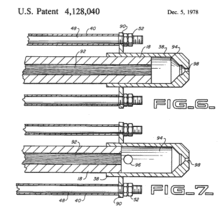Muzzle booster
A muzzle booster or recoil booster is a device affixed to the muzzle of a firearm, intended to harness the energy of the escaping propellant to augment the force of recoil on portions of the firearm. Muzzle boosters are usually used to improve the reliability of a recoil operated firearm. The muzzle booster is the antithesis of the muzzle brake, which is designed to use the propellant gases to reduce the recoil of the firearm.
History
The recoil booster was first introduced in the Vickers machine gun of 1912. The Vickers, like the Maxim gun from which it was developed, uses a short recoil action. At firing, the recoil from the cartridge pushes the barrel backwards within the gun. This movement provides the energy required to extract and eject the spent cartridge, and compresses the recoil spring to complete the cycle. The muzzle booster increased the recoil transmitted to the barrel by directing some of the escaping gas into pushing the barrel back rather than letting it all expand outwards at the muzzle. This increased the initial velocity of the barrel and lock, providing more energy for the operation of the mechanism.[1]
Construction
The booster on the Vickers consists of two parts; the first is a flared "cup" on the muzzle of the barrel and the second is a perforated tube around the end of the muzzle. As the bullet exits the barrel, it passes through the close tolerance hole in the end of the perforated tube. As it does so it temporarily forms a blockage to further forward movement of the expanding gas from the barrel. The pressure inside the booster rises, as the gases are forced to reverse direction to escape the booster. The cup on the muzzle of the barrel provides a large surface for the gas to push against, and the increased pressure accelerates the barrel to the rear. The resulting action can be seen as a composite of the recoil action and a gas action — the barrel being acted upon as if it were the piston.[2]
Historical applications
The original use of the recoil booster was to provide additional energy to move the large barrel mass on recoil operated machine guns.[3] The original 1915 model of the air-cooled lMG 08 Spandau German World War I aircraft machine gun possessed an "over-slotted" 103 mm diameter cooling jacket, an important supporting member for the gun barrel, that made it too fragile to use with a muzzle booster that later, less perforated cooling jacket versions of the lMG 08, and its follow-on, the LMG 08/15 aircraft gun could use. The World War II-era German MG42 was another such machine gun which also made use of a muzzle booster. This application has largely fallen out of use as modern machine gun design switched to delayed blowback and gas operation in many cases. The Rheinmetall MG3, essentially an MG42 modified to use the standard 7.62×51mm NATO round, and currently used by the German military, still uses a boosted short recoil design.[4]

Modern applications
Recoil boosters have found a use in suppressors on short-recoil operated pistols (i.e., most modern centerfire pistols chambered for 9mm and above). Such pistols have a barrel which recoils a short distance upon firing before unlocking from the slide (usually by tilting the barrel in order to separate the lugs on the barrel and the slide). Adding the extra weight to the barrel by screwing on a suppressor will interfere with the gun's ability to properly cycle the action after each shot, resulting in stoppages. By incorporating a recoil booster, often called a Nielsen device, the weight of the suppressor can be uncoupled from the barrel, allowing the pistol to function properly by boosting the recoil energy of the barrel and slide. Many suppressor boosters incorporate an indexing system which allows the suppressor to be reoriented in a number of different rotational positions, allowing the end user to fine-tune the weapon's point of aim.[5]
Some blank firing adapters (BFAs) act as recoil boosters, harnessing the gases produced by the blank cartridge to compensate for the lack of back pressure that would normally occur as the bullet keeps the propellant gases from escaping until the bullet clears the barrel.
-

Rear of a suppressor with the Nielsen device protruding (completely assembled).
-

Retaining ring unscrewed and Nielsen device partially removed.
-

Nielsen device completely removed and disassembled.
-

Rear of suppressor showing the rotational indexing system incorporated into some Nielsen devices.
References
- ↑ John Ivor Headon Owen (1975). Brassey's infantry weapons of the world: infantry weapons and combat aids in current use by the regular and reserve forces of all nations. Bonanza. pp. 109–110. ISBN 978-0-517-24234-6.
- ↑ Weeks, John (1972). Infantry Weapons. Pan Books. p. 16.
- ↑ Cutshaw, Charles Q. (2011). Tactical Small Arms of the 21st Century: A Complete Guide to Small Arms From Around the World. Iola, Wisconsin: Gun Digest Books. p. 40. ISBN 978-1-4402-2482-9.
- ↑ Heard, Brian J. (17 August 2011). Handbook of Firearms and Ballistics: Examining and Interpreting Forensic Evidence. John Wiley & Sons. p. 43. ISBN 978-1-119-96477-3.
- ↑ Walker, Robert E. Cartridges and Firearm Identification. CRC Press. p. 380. ISBN 978-1-4665-8881-3.